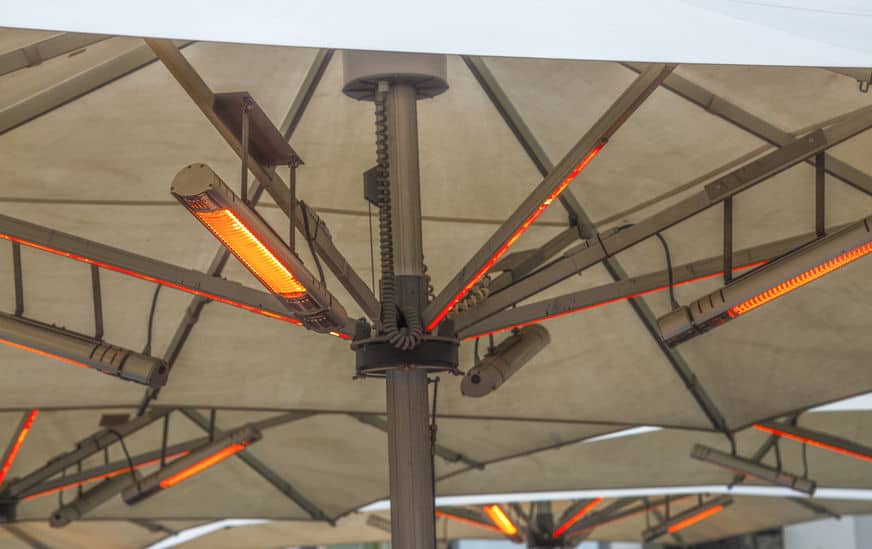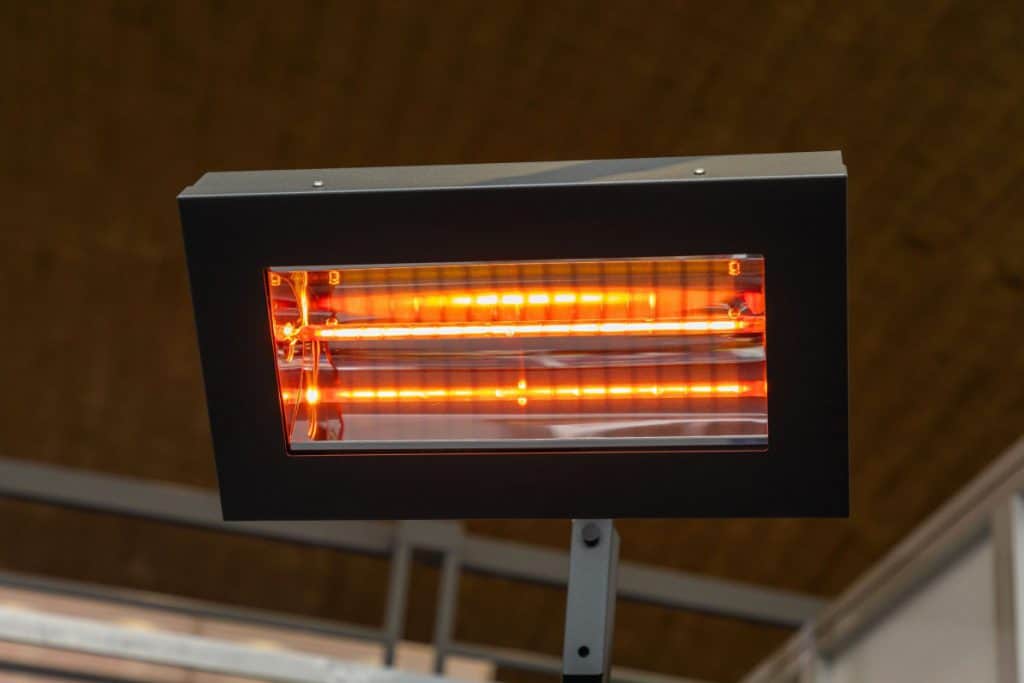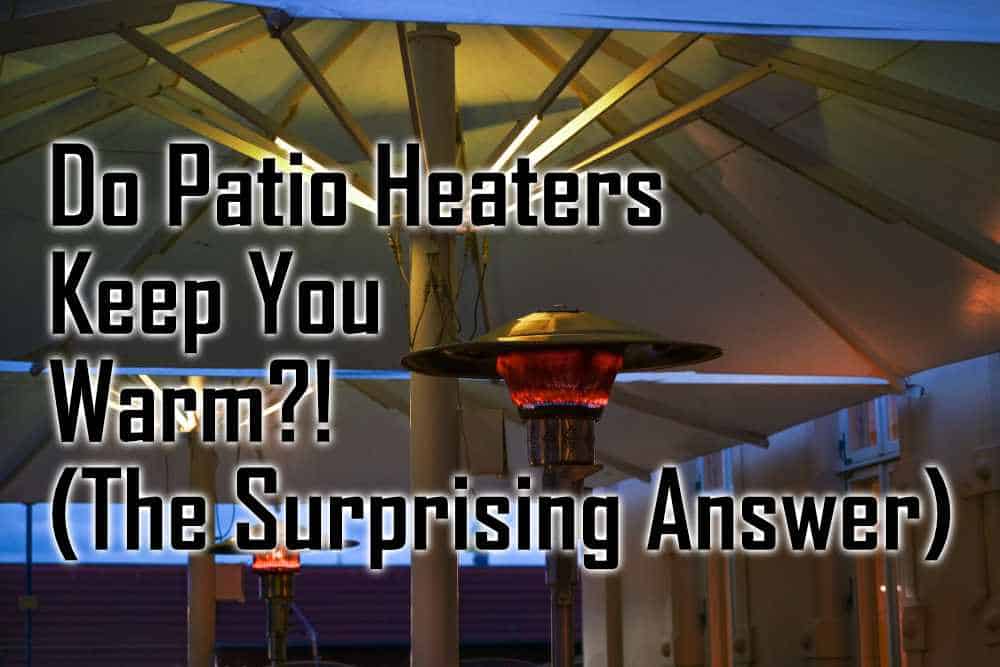Do you love throwing outdoor gatherings but despise the fact that it’ll be too cold outside?
Are you tired of spending the frosty winters not being able to escape the blistering cold?
Do you dread when your feet feel almost frozen and the tip of your nose numb? Fear not, we’ve got the solution to all your ailments and dilemmas; a patio heater.
A patio heater, also known as a mushroom or an umbrella heater (because of its uncanny structure), is an outdoor heater specifically designed for gatherings pertaining to open air, hence the name.
Patio heaters don’t usually get the hype they deserve, and we’re going to tell you exactly why they should.
As winter is definitely here (Game of Thrones fans would agree), read on to find out more about patio heaters and the ever unsolved question: Do patio heaters actually keep you warm?
There are two main ways in which patio heaters provide warmth and the feeling of being at home to the customers:
- By using propane based fuel in cylinders placed at the bottom of the heater panel, usually hidden by the eye. Using that fuel, the heaters emit or radiate heat.
The advantages of using this type of fuel is that it doesn’t need to be installed, gives good heat intensity, plus is convenient for when you want to move the heater here and there. Although one misfortune would be that the cylinders used would need to be replaced because the fuel would run out.
More importantly, for the same heat output, this kind of fuel usually costs more than electricity.
- By using a renewable energy source like electricity or wood to radiate heat to keep you feeling warm and at home. This type of energy source despite needing installation has proven to be cheaper, safer, and convenient, also easier to maintain than other forms of fuel used for the patio heaters. Also, it’s environmentally friendly!
How to choose the correct heater?
The dilemma still remains, how to know what type of patio heater to choose?
As every technology does, this type of heater too has a myriad of types you can choose from!
Ranging from umbrella-shapedshaped ones to the more outward looking to even the ones containing a glass dome, the possibilities are many.
Let us tell you a bit more briefly about the features each kind of heater has to offer as to make your heating job easier:
Floor-based heaters
This is the most common choice for all the customers out there interested in purchasing an outdoor heater, a reason for which would be its sleek and slender mainframe and structure.
They require little to no effort in the installation process. These sorts use gas as a main fuel source for the heater and are most commonly used in bigger restaurants, and eateries as well as some private gatherings.
If you have a big social circle and tend or wish to hold a lot of outdoorsy gatherings then this is the type that will keep you warm enough.
Wall hanging heaters
As the name suggests, these sorts of heaters are usually found mounted on the ceilings or to the walls.
They require expertise to be properly installed and these heaters prove to be feasible as they don’t get in your way and keep the space lavish, comfy and artistic at the same time.
These can keep you warm too, but at a more local scale than floor-based ones, since you can’t move them around easily. But the fact that they add a new and eye-catching aesthetic to the overall look of the place doesn’t hurt as well.
Tabletop compacts
These heaters display an adorable sight when placed atop any of your tables or stools.
These prove to be an affordable purchase since they’re usually very small in size and tend to not take up a lot of space, so it’s a space-friendly option while also warming up a smaller audience.
Given all the facts and figures, pros and the occasional cons, we hope the choice must now be fairly easier than before.
Does the placement of the patio heater make a difference?

After the various types of heaters, let’s jump into the question of how and where to place the heaters in order to get the maximum warmth and benefit.
Naturally, distance and how much heat you’ll get at it is a factor that we need to consider when deciding where to place the patio heater, and at what distance.
Here are some factors that you need to keep in mind before deciding placement:
- Heating direction is important when deciding the placement since some heaters radiate heat upward to downwards and some from one side to the other. Depending on the design and type of the heater (from the ones mentioned above) the heater should be placed where the heat reaches the audience.
- Safety and safe distance is the most important thing to consider once you’ve purchased your patio heater. While making sure the heater is facing the audience you must also make sure that the heater is not too close to the people or else it will cause them bodily harm. You want to keep it warm, but not too hot for comfort.
Furthermore, keep your heater far away from things that are flammable as well as material that can combust easily and fairly quickly.
This should be done in order to avoid any small-scale explosions that may result in bodily harm.
Also note that these heaters must only be used outside and not inside the house.
If the outside area is a tent or a semi enclosed area, then it needs to have proper ventilation so that the harmful gases omitted by the patio heater do not get trapped and damage people’s lungs.
They’ll still provide heat if used indoors, but they’re not meant to be used indoors! You might end up feeling suffocated instead of warm.
- Solid base. One big no-no of placing the patio heater is at a rocky or uneven surface. This makes the heater wobble and could fall and be a hazard to the public standing or sitting around it. To avoid this risk, the heater must be placed at a solid and even surface.
This will give the heater the footing it needs to remain steady and stable. And of course, if it doesn’t fall, it won’t be damaged, and it’ll perform its job well for longer.
- Square foot. Each patio heater comes with a heat intensity degree and the amount of square area it can disperse heat to when turned on. This is called the square foot area per heater and is measured by BTU (measuring unit).
So, the heaters must be placed according to the range of square area they can omit heat to. Otherwise, you can’t really complain if the heater doesn’t keep you warm.
You’re just out of its range (which is specified in the specs you should read before you buy one!).
- Fuel source. The fuel source matters too, because usually for the same price, an electric heater would provide you more heat output than a propane one.
Also, when using natural gas and propane, the cylinders must be handled with extra caution as per to avoid any leakages or damages that might cause a combustion later on if left unattended.
- Natural phenomenon and magnitude of the gathering. You should place the heater in a way that it isn’t facing the direction opposite that of the wind. Naturally, if the wind is stronger, it would just blow a lot of the hot air against the heater’s direction, not letting enough warmth reach you.
So, you must be smart enough to place the heater facing the same way as the wind’s direction.
There must also be a veil over the top of the heater to make it resistant to weather intensities and changes.
Also, the heater must be placed based on the size of your guest list. If the guests are more in number, there must be at least one patio heater per 25 guests to ensure efficient allocation and dispersion of heat.
Does using a directional heat shield help?

A directional heat shield or more commonly known as a directional heat reflector is a heat shield that is put onto the top of a patio heater. This reflector shield will help distribute heat more intensely and efficiently by:
- Focusing the transfer of heat reversibly by altering directions and angles best suited to maximize heat intensity and distance, increasing the functionality of the outdoor heater.
- Making the patio heater last a longer while by minimizing the effects of natural phenomenon such as rainy days and intense winds on the patio heater’s intensity. Since patio heaters and usually methane powered, a directional heat shield helps protect it efficiently and makes it last a while, which is to say, it increases the patio heater’s durability and the number of years it can keep you warm!
- The feasibility to install. Anyone with minimal knowledge could install it and it wouldn’t cost much at all. It can be installed anywhere and everywhere you wish since it doesn’t require a particular installation method. Furthermore, it comes with a protective covering for extra precaution, not to mention the fact that it is imperceptible to rusting!
- It is convenient and portable, easier to carry anywhere and everywhere, hence the convenience of moving it along with your heater and maximizing warmth wherever you go!
- It reduces heat emissions and increases safety by focusing on using less energy and fuel, hence the heater lasts longer, and its heat and energy distribution remains even. It also reduces the safety risk, hence proved user friendly.
Keeping all that in mind, a patio heater can do its heating job pretty well if you know which one to buy and how to use it properly!
Alright guys, that’s it for this article, if you are interesting in reading more about patio heaters, we have lots of cool articles related such as:
Can Patio Heaters be Used on a Deck (Read This First!)
Can Patio Heaters be Used on a Screened-in Porch? (Quick Facts)

